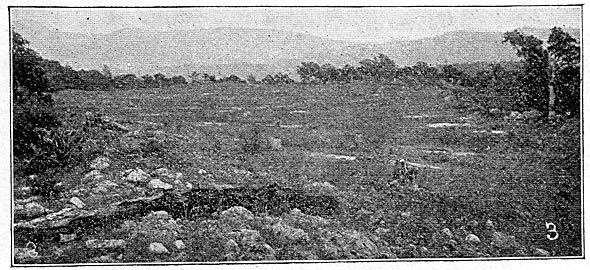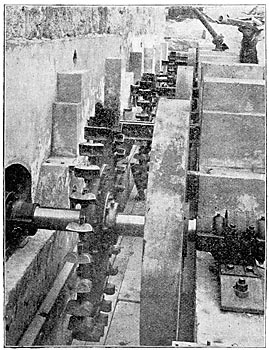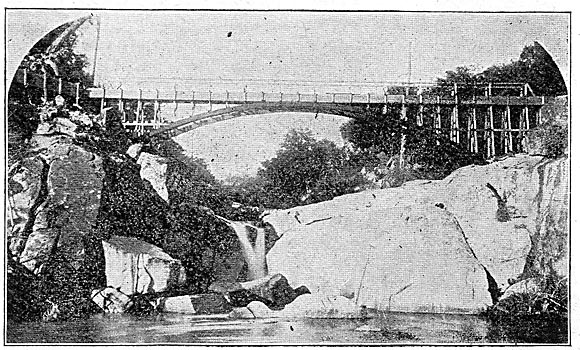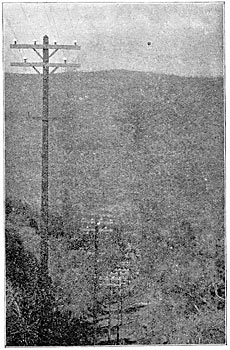[Trade Journal]
Publication: Electrical World
New York, NY, United States
vol. 27, no. 22, p. 661-662, col. 2, 1-2
The 35-Mile Three-Phase Transmission at Fresno, Cal.
The work on the three-phase transmission of electrical energy to Fresno, Cal., which has been carried on for the past year, is rapidly drawing to completion. This transmission will be the longest and most unique in many ways ever effected commercially, and will result in endowing Fresno and the surrounding towns and villages with a system of light and supply of cheap power equal to that of any eastern city situated in proximity to P. coal centre.
The power-house is located on the North Fork of the San Joaquin River, in Madeira County about 35 miles northeast of Fresno, at the foot of a steep hill and facing one equally as steep.
The point of diversion lies some miles away, where the North Fork runs through a narrow canyon with solid rock walls. A flume and ditch with a total length of seven miles have been built and excavated on the easy side hill slopes, and the right of way has been cleared of all trees and obstructions for a width of 150 feet. The grade of the canal and flume is 5.28 feet to the mile. The lower bank of the canal is sufficiently wide to serve as a wagon road for the inspection teams. The minimum low water flow of the stream at the point of diversion is 5o cubic feet per second, which will develop, at the head available, over 7000 horse-power at the water-wheels.
| |||
| Site of Reservoir. |
The intake is located at a natural dam and the headgates and canal are cut in the solid rock. So rapidly does the river fall at this point that the canal 300 feet from the headgate is 30 feet above high water mark. This frees it from all danger from freshets. The entire system of headwork and canal is below frost line and thus is not subject to effects of snow or cold.
At the end of the canal is a natural basin which covers several acres and has a dyke of rock extending about three quarters of the distance around its circumference. With an expenditure of less than $3000 an embankment has been constructed for the remaining distance and a reservoir formed, which at a maximum depth of water of only 10 feet will hold sufficient water to operate the plant at full load for several days consecutively. By means of this provision it is also possible to shut off the ditch for repairs or change.
The reservoir is situated at the top of a high hill, the river being some 1600 feet below. The pipe line leading from the pressure box in the reservoir is 4100 feet long, and in this distance the vertical difference in level is not less than 1400 feet—one of the highest heads of water ever used for power purposes. For the first 400 feet the pipe is of steel, riveted. For the balance of the distance it is of lap-welded pipe with lock joints, five eighths of an inch thick at the lower end with a diameter of 22 inches.
| |||
| Pelton Wheels Outside the Power House. |
| |||
| Flume Crossing the North Fork. |
At the power-house the pipe enters a receiver of three-quarter-inch steel, 57 feet long and 30 feet in diameter. The joints are of the butt strap type, and the receiver is designed to stand a working pressure of 800 pounds per square inch.
The power-house is of native granite, is 75 feet long and 30 feet wide, with a wooden roof. The water-wheels are outside the main power-house, the shafts passing through the heavy granite wall, which effectually keeps all water and moisture out of the dynamo room. The three wheels are of Pelton make, 57 inches in diameter, each capable of developing 500 horse-power at 600 revolutions per minute under an effective head of 1410 feet. They have steel-plate centres and bronze buckets, and are fitted with fly-wheels five feet in diameter. Separate wheels are provided for the exciters.
The electrical installation is not yet completed. It will consist of three General Electric Company's three-phase generators each of 350-kw capacity, directly connected to the water-wheel shafts. The current will be raised in transformers to 12,000 volts and will be carried on a pole for 34.4 miles to the substation at Fresno. It will then be transformed down to 200, 1000 and 3000 volts, the first for the low-tension supply in the business portion of the city; the second for the three-phase supply in the residence districts; the third for the three-phase supply to the vineyards and wineries within a radius of to miles from the substation.
| |||
| View of Pipe Line and Pole Line. |
Contiguous to the station is the pump house of the Fresno Water Company in which the pumps are already operated by a 75-hp, three-phase induction motor. This is the first motor operated by the transmitted current.
The completion of the work is being rapidly pushed forward. Within a few weeks it will be finished and another great step forward in the electrical transmission field will have been made.




